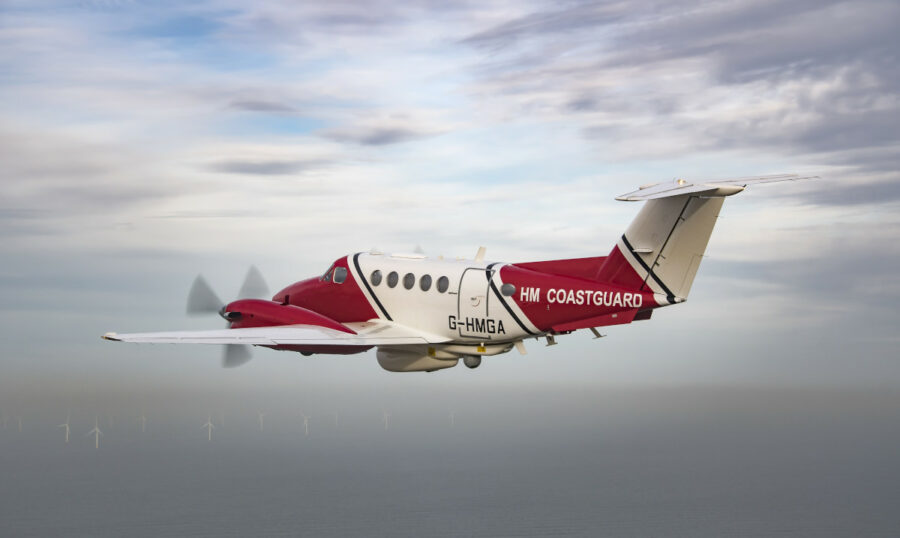In a big hangar at Doncaster Sheffield Airport sit two red and white twin-engined aeroplanes in HM Coastguard livery. John Worrall reports
In fact, there are four aeroplanes – along with a red and white Boeing 727 marked ‘Oil Spill Response’, which is another, if not unconnected, story – but the two are new arrivals.
They are Beechcraft Super King Air B200s, packed with state-of-the-art surveillance equipment for search and rescue, pollution detection and other maritime work, and they mark a significant expansion of MCA capability, as commercial and programmes director at the MCA, Damien Oliver, explained. “Eighteen months ago, we launched a tender for what ostensibly was a replacement of our planes, which historically enabled us to detect pollution on the water. But we had ambitions to broaden the scope to do other things such as supporting search and rescue operations.
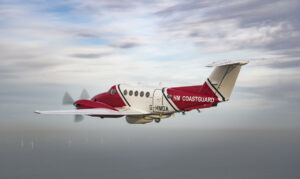
The new Beechcraft Super King Air B200 G-HMGA on patrol.
“These Beechcraft King Air B200 aircraft are a welcome addition to the MCA’s fleet of helicopters and planes and boast state-of-the-art cameras and sensors that can detect people in the water at considerable distance. The aircraft will also provide assistance to other public bodies in the work that they do.”
The five-year contract to acquire, equip and operate the planes was awarded to aviation company 2Excel on 19 March last year, and it’s in their hangar that they are now based.
The ‘considerable distance’ at which they can detect people in the water is a key point, because ‘considerable’ is up to 40 miles, at which range they can perhaps even distinguish between a distressed person and a self-satisfied seal. They can then guide rescue helicopters from one of the 10 bases around the UK, which on average respond to seven incidents each day and rescued more than 1,600 people last year.
But why are Coastguard aircraft based at Doncaster, which is not, after all, on the coast?
First of all, it was already one of 2Excel’s operational bases. But one attraction of the 2Excel bid was that Doncaster is close to being in the middle of the country, which puts the overall UK coastline more within reach. The King Airs, each crewed by a pilot and a sensor operator, have a six-hour endurance and an operational radius that covers the whole of the UK EEZ and can stretch to the 20W meridian, which is nearly as far again as the west coast of Ireland.
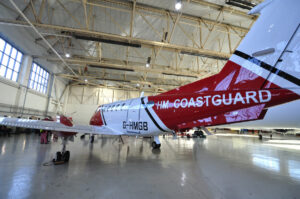
G-HMGB, not yet with its radar pod, looked good in the hangar.
2Excel was formed in 2005 by two ex-RAF fighter pilots who initially set up an aerobatic display team, The Blades – but although that four-plane team, based at Sywell aerodrome in Northamptonshire, is still very much in the display business, the two prime movers went on to develop what has become a multifaceted aviation business with a staff now approaching 500 and an annual turnover of more than £45m.
It comprises two sections: 2Excel Engineering, which provides maintenance, repairs and other operations at its base in Hampshire, and Excel Aviation Ltd, based in the Doncaster hangar, offering a range of services from VIP charters to special missions for government and industry.
2Excel picked Doncaster as its base several years ago because of that central location, along with its 10,000ft runway and the fact that it is open 24 hours a day. The company’s charter Boeing 737 and its two oil spill response 727s are based there, although it doesn’t presently hold the MCA pollution dispersal contract, which is with another operator.
The King Airs join two MCA Piper PA31 Navajos which, each with a similar crew and range if less whizzy kit, are also now part of 2Excel’s contract. All four aircraft fly routine patrols, but can each provide back-up if another needs refuelling or is diverted to a search and rescue/threat-to-life incident.
Arnie Palmer, director of 2Excel special missions, says that the King Air package was put together from scratch, from the acquisition of the aircraft through to the choice and installation of the sensor systems.
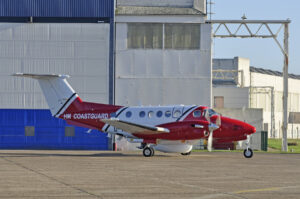
G-HMGA was scrambled before attendees at the press day could get a good look.
“The work, which was completed over an eight-month period, drew on expertise across 2Excel, including our capability development team – from integrated design, manufacturing and installation of the specialist mission equipment to training our crews to operate the aircraft.”
The first of the two, G-HMGA, became operational on 19 November, and the second, G-HMGB, followed shortly after.
And so, on a fine winter’s day in February, the fully shaken-down two of them were presented to the press. The original plan was for the full range of capability to be demonstrated on screens in G-HMGA, which stood outside on the apron in the sunshine, but at the crucial juncture, it was scrambled for a mission.
To those of us of a certain age who have watched a few Battle of Britain films, ‘scramble’ conjures images of chaps with handlebar moustaches breaking off from reading the paper or a game of draughts, throwing still-smoking pipes to their batmen and rushing off across the grass to their aeroplanes shouting “Tally-ho!”
But a Coastguard scramble – for these longer-range surveillance platforms as opposed to the search and rescue helicopters, anyway – is more considered, the aim being to be airborne within 45 minutes after full briefing. The call-out that morning was the 79th in the 80 days since the first roll-out, and the two aircraft had by then flown over 200 hours on search and rescue, fisheries and counter-pollution patrols.
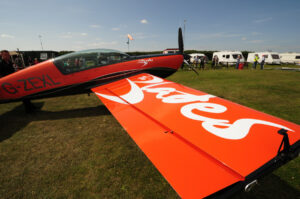
2Excel started with The Blades aerobatic team.
Matt Tones, head of surveillance at 2Excel, says that the sensor package provides the real cutting edge, specifically the primary sensor, the Osprey 30 radar from Leonardo housed in a pod under the fuselage, which gives that huge detection range.
“Right now, only one of the aircraft has that system, because the original best-value-for-money calculation was to have two aeroplanes with one pod transferable between them at the 200-hour service interval, so that optimum capability was always available. The non-podded aircraft anyway has Leonardo’s SeaSpray 7500E radar, which from 26,000ft can see about 200 nautical miles and detect a man in the water from 10 miles. But the MCA has now opted to buy another Osprey 30 system, and so both aircraft in the very near future will have a full set of sensors.
“On search and rescue, the King Airs can locate the casualty and then guide the helicopter in, and one of their great benefits is that they can loiter when helicopters are at extended range, to give top cover and help with communications.
“Both also have Westcam’s MX15 Electro Optical Infrared high-definition camera system, together with long-wave IR and UV line scanners, which are really useful for detecting pollution. It’s very capable day or night.

G-HMGB in its hangar…
“On the front of the aircraft, there is the direction-finding system, which works on any of the maritime VHF frequencies and will also detect 406MHz frequency beacons. There is also an AIS receiver.
“And then on the roof and back there is a very sophisticated communications system – two channels of satellite data, effectively putting the internet into the aeroplane. That allows us to stream onboard to bring information in.
“Comms-wise, we have a radio which is futureproof and will talk to anybody from 30 to 900MHz. It can also take external radios, so you could walk onto the plane with a two-way handset or a military radio and plug it into the aircraft radio.”
Michael King, aviation technical lead for the MCA and part of the team that set the contract’s requirements, points out that the onboard kit works as part of a wider communications network.
“What helps gel all of it together is the Aeronautical Rescue Co-ordination Centre at the National Maritime Operations Centre down at Fareham. It’s manned by coastguards 24/7 and does a lot of the co-ordination for 2Excel, as well as for our search and rescue helicopters. The MCA is also a signatory to the European Space Agency’s Copernicus system, from which we receive information.
“As technology moves forward, we are keen to develop the capability, but this new stuff isn’t like bolting a new sound system into your car. There is a whole regulation piece that goes with it.”
And it’s also a question of making the most of the capability. “Counter-pollution sits within the MCA, and the radar can spot the difference in sea movement where a pollutant is causing the water to behave differently. So we can see pollution from a long way away, and the scanners, IR to UV, can give an idea of how thick or how thin the pollutant might be. While people get very focused on oil, it’s also about wood slicks, containers – loads of stuff.
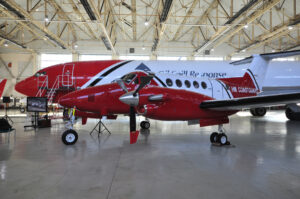
… alongside the larger Oil Spill Response Boeing 727.
“But when we were putting the requirements together, we were very cognisant of value for money for UK taxpayers, and so we involved other government agencies with a maritime interest to look at their requirements and see where we could help them. And so we are, for example, able to support the MMO on marine management and fisheries.
“But then, of course, we have the Coastguard emergency service. This King Air is a far more capable platform. It will go further and faster and higher, and the Osprey sensor kit is a big second to none.”
So far, since November, there have been a lot of routine patrols – on pollution and on fishing – but there has already been some reactive work. Back in December, some containers were washed overboard, and they looked for those.
And in addition to rescue assistance and patrols looking for pollution and illegal fishing (four Fishery Protection Squadron vessels currently cover UK waters), the new aeroplanes will be monitoring safety-at-sea issues. The MAIB database of marine accidents between 2000 and 2018 records 159 fatal drowning accidents from UK-registered fishing vessels, and in two-thirds of cases, the fatalities were not wearing PFDs.
So does that mean looking closely at PFDs on fishermen? “Yes, definitely. It’s a key thing this year, enforcement of PFDs on commercial boats.”
So there you have it, chaps – ILO 188, marine guidance note 588 and all that. The eyes in the sky are watching you, and they can see whether you’re properly kitted out long before you can see them. And if you’re not, there could be trouble, because if you go overboard, it’s them who will have to get you pulled out and – whizzy aeroplanes or not – time will be of the essence, and your survival chances need to be maximised.
So clunk click, or a plastic equivalent thereof – and let’s hope that someone soon designs a PFD that doesn’t get uncomfortable after a few hours hauling pots…

